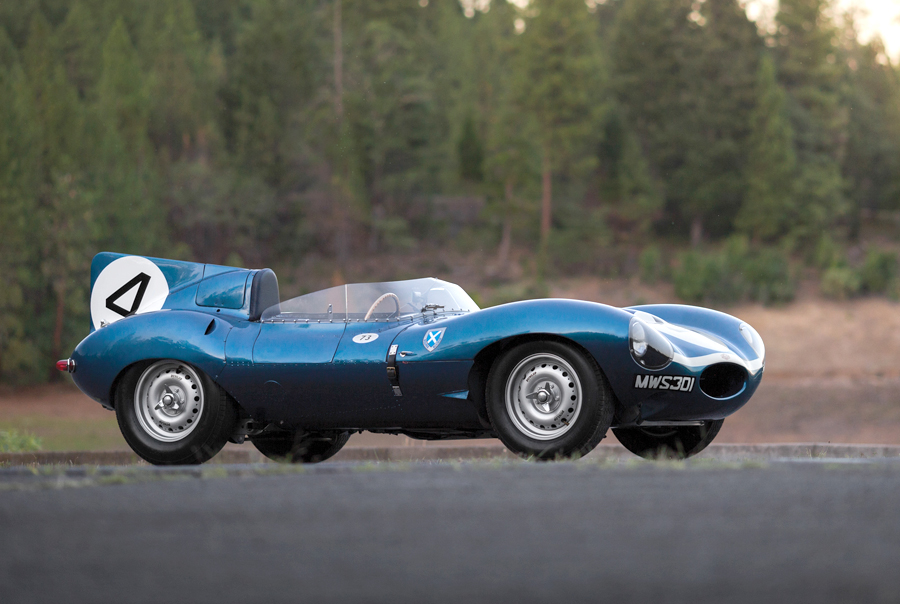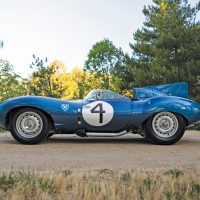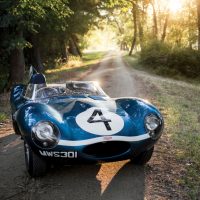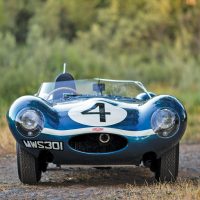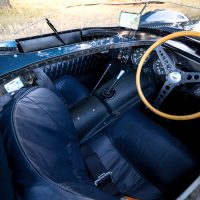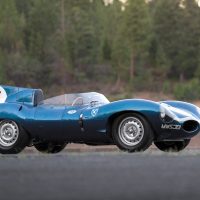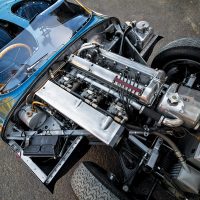Following their win at Le Mans in 1953, where Duncan Hamilton and Tony Rolt led a veritable parade of C-types to three of the top four finishes, Jaguar faced a problem. The limits of the XK 120-based race car had been reached, and in order to remain competitive at Le Mans, a new car would be required.
While the C-type had been one of the first cars of its era to employ a steel-tube space frame, its successor was perhaps the first to claim unitary monocoque construction, with the body and frame combining for structural integrity. The successful and proven 3.4-liter XK engine was retained — but now fitted with triple Weber carburetors good for 245 horsepower. A dry-sump lubrication system was also adapted that reduced height, allowing the engine to be mounted lower, and correspondingly reducing the overall profile and coefficient of drag. It was clear that the design was effective when one of the new cars hit 169 mph on the Mulsanne Straight at the Le Mans trials in April 1954. As the previous Jaguar had been called the C-type for “competition,” the new Jaguar was dubbed the D-type.
Chassis number XKD501 was the first D-type produced for a private team, sold to the Scottish racing team Ecurie Ecosse, and dispatched on May 5, 1955. XKD501 was liveried in the team’s signature colors with the St. Andrew’s Cross emblazoned on the front fenders.
SCM Analysis
Detailing
| Vehicle: | 1955 Jaguar D-Type |
| Years Produced: | 1954–56 |
| Number Produced: | 71 |
| Original List Price: | $11,000 |
| SCM Valuation: | Median to date, $4,311,400; high sale, $21,780,000 (this car) |
| Chassis Number Location: | On top of left front suspension |
| Engine Number Location: | On head between cam covers, on right side of block above oil lines |
| Club Info: | Jaguar Club of North America |
| Website: | http://www.jcna.com |
| Alternatives: | 1954 Ferrari 375 MM+, 1957 Ferrari 315 S, 1955–56 Ferrari 860 Monza |
| Investment Grade: | A |
This car, Lot 114, sold for $21,780,000, including buyer’s premium, at RM Sotheby’s Monterey auction on August 20, 2106.
For any of you who doubted that an English racer with a production-based, iron-block straight-six engine could reach the stratospheric values normally associated only with Ferraris, here is your answer: yes.
That said, it took an extremely special car to do it.
The real question that is left hanging for now is whether this presages a general move in the perceived value of English racing cars or was just an aberration — an extraordinary result for a very special car. I don’t know, either, but it is certainly worth considering the facts and circumstances surrounding this sale to see if we can glean insights.
I’ve already written two profiles of D-type Jaguars, so I’m not going to burden you with too much history, perspective, or mechanical detail this time. Suffice it to say that Jaguar stood the production sports car world on its ear with the XK 120 — and then established a new standard for technical and engineering excellence for the racing car world with the C-type.
When it came time to supersede the C-type, Jaguar forced an entire paradigm shift in the racing world with the D-type.
With monocoque construction, disc brakes, extraordinary aerodynamics and blank-sheet-of-paper technical innovation everywhere, the new D-type was a sleek P-51 Mustang in a world of radial-engined fighters. Once it showed up, everyone else had to go back to the drawing board.
This is not to say that there wasn’t serious competition — only that the writing was on the wall.
Three keys to a winner
To start with, like the P-51, the D-type was designed for a specific type of battle — Le Mans and the endurance racing tracks of the time; fast, open tracks that favored top speed and stability over nimble handling. As a result, the D-type never showed well (if it was entered at all) in “twisty” events such as the Mille Miglia.
Second, there was no effective displacement limit until 1957, so simple horsepower was a competitive option.
Jaguar used its production-based 3.4-liter engine (later 3.8) and relied on aerodynamic slipperiness and disc brakes for lap speeds, while Ferrari utilized 4.5- and 4.9-liter V12 engines powering much less sophisticated chassis and bodywork in a brute-force approach to finishing first.
Aston Martin’s DB3S used a 3-liter engine in a very small, light and aerodynamically efficient package that proved very competitive. In 1955, Mercedes-Benz joined the fray with the 300SLR — probably the ultimate racer of the 1950s. Although utterly superior in every respect, tragedy intervened at Le Mans, and the 300SLR quickly became an almost mythical, unattainable pinnacle of achievement consigned to memory and museums.
The third factor for achieving dominance was mechanical reliability. Although the engine, chassis and suspension proved bomb-proof, the new Dunlop disc brakes had some teething troubles.
Our subject car had two serious accidents, one moderate (through a hedge and into a ditch) and one major (end over end) due to brake failures. Both times it was sent back to the factory for repairs (the second one took a month). The D-type was not an early bloomer.
One of the greatest racers
The D-type proved to be a remarkably resilient design, and over the years actually got more competitive — honestly earning its iconic status as one of the greatest of all racing cars.
Le Mans performance was its forte. In its maiden year of 1954, the D-type came within a lap of winning over a 4.9-liter Ferrari, as the two other factory team cars succumbed to mechanical woes (brakes and fuel feed respectively).
In 1955, the D-type won Le Mans, but the victory was hollow after the withdrawal of the Mercedes SLRs due to the tragic crash. In 1956, bad luck and mechanical issues prevented an extremely fast factory team from winning, but Ecurie Ecosse — in our subject car — managed to best the field and win, even though the car was old and carried a 3.4-liter engine. In 1957, even though the factory had quit racing, privateer D-types swept the first four places — and five of the first six positions.
Until Porsche almost two decades later, there has never been such a successful endurance-racing car.
Trailing Ferrari in the market
For all their beauty, success, and historical importance, the D-type Jaguars have never carried the cachet or collector value of the Ferraris they ran against — and frequently beat.
This may be because Jaguar built quite a few of them (71) while Ferrari never built more than a few of their factory team cars. Or maybe it was just the undeniable Italian mystique.
The obvious explanation appears to relate to the engine. With the exception of a bank of Webers (or fuel injection on a few), the engine looks and sounds exactly like every road Jaguar built between 1948 and 1971. This is a fabulous endorsement for the road cars, but not so much for the racers. Interestingly, for the past number of years, D-type prices have correlated nicely with the 4-cylinder Ferrari 860 Monzas, which are valued at about a third of the 12-cylinder racers.
Our subject car
Let’s look at traditional bases for value on our subject D-type.
The car’s history is extensive and very good, but it is not a full factory team car. The configuration is pretty ordinary, as it is an early short-nose, customer-specification, 3.4-liter engine car.
The car’s originality is interesting, as it has been massively repaired at the factory twice, so little of the metal in it was as delivered new. However, virtually every piece now on the car was there when it had its moment of glory at Le Mans.
At this point it is a very good, original-with-explanations privateer D-type, and it was probably worth $6 million to $7 million last July.
Now add that it won Le Mans in 1956, and on top of that is the only surviving Le Mans winning D-type. The 1955 and 1957 winners were both broken up, and although they are now reconstructed, they are far from original.
Winning Le Mans is the ultimate collectibility accolade in the racing-car world, and a win is generally worth at least a doubling in a car’s value. In this case, it was apparently worth a tripling in value, which seems a lot.
A Le Mans boost or a market jump?
The real question is whether the “Le Mans effect” was really that strong or whether the underlying value of D-types has jumped.
English car lovers have long felt that both C-types and D-types have been seriously undervalued relative to their Italian equivalents, and there are good arguments to be made.
Chris Keith Lucas of CKL Developments, the ultimate racing Jaguar guru, tells me that his D-type owners have already adjusted their internal valuations upwards.
Time will tell, and the next few sales will be interesting to watch. XKD501 was a crown jewel and undoubtedly the most valuable D-type in the world. The buyer knew what he was buying and why. I have to assume it was fairly bought. ♦
(Introductory description courtesy of RM Sotheby’s.)
